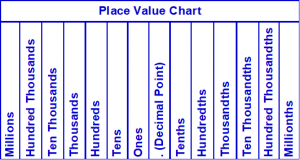
- The Place Value of a digit is based on what place or position it occupies in a number
- Example: The Place Value of 3 in 437 is 30 since 3 occupies the Tens place and 3 * 10 = 30
- Because there is no single digit in the base-10 numbering system greater than 9, the value of each place is 10 times greater than the value of the place to its immediate right
- Example: A 2 in the Hundreds place has a value (200) that is 10 times greater than the value of a 2 in the Tens Place (20), and the value of the 2 in the Tens place has a value 10 times greater than the value of a 2 in the Ones place (2)
- Application: Expressing a number in expanded form
Positional notation (or place-value notation, or positional numeral system) denotes usually the extension to any base of the Hindu–Arabic numeral system (or decimal system). More generally, a positional system is a numeral system in which the contribution of a digit to the value of a number is the product of the value of the digit by a factor determined by the position of the digit. In early numeral systems, such as Roman numerals, a digit has only one value: I means one, X means ten and C a hundred (however, the value may be negated if placed before another digit). In modern positional systems, such as the decimal system, the position of the digit means that its value must be multiplied by some value: in 555, the three identical symbols represent five hundreds, five tens, and five units, respectively, due to their different positions in the digit string.
The use of a radix point (decimal point in base ten), extends to include fractions and allows representing every real number up to arbitrary accuracy. With positional notation, arithmetical computations are greatly simpler than with any older numeral system, and this explains the rapid spread of the notation when it was introduced in western Europe.
The Babylonian numeral system, base 60, was the first positional system developed, and its influence is present today in the way time and angles are counted in tallies related to 60, like 60 minutes in an hour, 360 degrees in a circle. Today, the Hindu–Arabic numeral system (base ten) is the most commonly used system, all around the world. However, the binary numeral system (base two) is used in almost all computers and electronic devices because it is easier to implement efficiently in electronic circuits.

